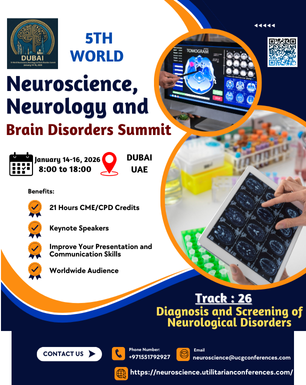



Sub Topics: Molecular and Cellular Neuroscience, Cognitive Neuroscience,...

Sub Tracks Clinical Neurology, Neurodegenerative...

Diagnosis and Screening of Neurological
Disorders
Neurological disorders encompass a wide range of conditions that affect
the brain, spinal cord, and peripheral nerves. The diagnosis and screening of
these disorders are critical for early detection, management, and treatment.
Accurate diagnosis involves a combination of clinical evaluation, medical
history review, and various diagnostic tests. Below is an overview of the
approaches used in diagnosing and screening neurological disorders.
Diagnostic
Imaging
Imaging techniques provide essential information to diagnose and monitor
neurological disorders. Common imaging modalities include:
Magnetic Resonance Imaging (MRI):
Indications:
MRI is used to detect structural changes in the brain and spinal cord, such as
tumors, multiple sclerosis, stroke, or atrophy in neurodegenerative diseases.
Advantages:
Provides detailed images of soft tissues without using radiation. It is
particularly sensitive in detecting changes in the brain and spinal cord.
Dementia and
Alzheimer’s Disease:
Early screening involves
assessing cognitive function through questionnaires (e.g., Mini-Mental State
Examination (MMSE)) and neuropsychological testing. Imaging (MRI or PET) can
help detect characteristic brain changes.
Stroke:
Screening for stroke risk
factors includes blood pressure measurements, cholesterol testing, and
assessing cardiovascular health. In case of suspected stroke, urgent imaging
(CT or MRI) is critical for diagnosis.
Multiple
Sclerosis (MS):
MRI is the primary tool for
detecting lesions in the central nervous system. Lumbar puncture can also be
used to examine for oligoclonal bands in CSF.
Parkinson’s
Disease:
Diagnosis is largely clinical,
based on symptoms like tremors, bradykinesia, and rigidity. Imaging can help
rule out other conditions, and dopamine transporter (DAT) scans can help
support the diagnosis.